Modernisms: Iranian, Turkish, and Indian Highlights from NYU’s Abby Weed Grey Collection
Written by CIMA 2019 interns, Olivia La Manna and Deborah Bosa
On October 23rd, 2019 CIMA members had the opportunity to visit NYU’s Grey Art Gallery for the exhibition Modernisms: Iranian, Turkish, and Indian Highlights from Abby Weed Grey’s private collection. Abby Weed Grey attended Vassar College, an all female institution located in Poughkeepsie, New York. After graduating in 1924, Abby spent the next few years (what she considered her “wander years”) traveling abroad with a college roommate to Riga, Latvia, and Paris, France. When Abby returned to the states, she met her soon to be husband, Lieutenant Colonel Benjamin Edwards Grey. In 1928 she became engaged and a year later married Benjamin Grey. After 27 years of marriage, Ben passed away, leaving Abby with a large sum of money which he collected from investments of Western Railroad stocks and Bonds.
In 1960, four years after her husband had passed away, Abby Grey took her first trip around the world with a group of thirteen women to Japan, Hong Kong, Thailand, Cambodia, India, Kashmir, Nepal, Pakistan, Iran, and Israel. It was during this trip that Abby began her search for an innovative artist by meeting with working with local artists and collecting contemporary art to be shown in America. A year later after this initial trip, Abby founded the Ben and Abby Grey Foundation, Inc. This foundation encouraged the cultural exchange program of international art, especially Middle Eastern and Indian works of art.
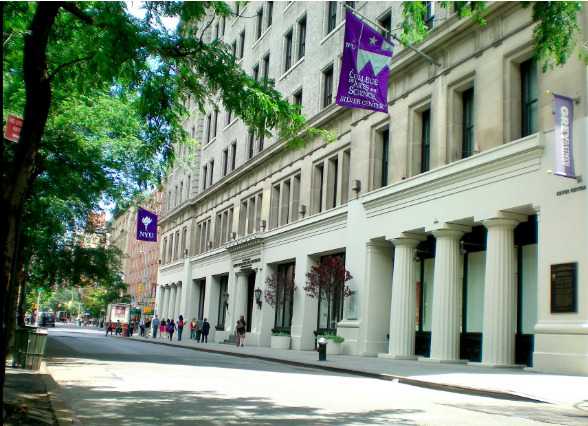
Throughout the rest of the 1960s and early 1970s Mrs. Grey initiated many projects and art ventures. These included “Fourteen Contemporary Iranians” (1962-65), which toured American cities, as did “Turkish Art Today” (1966-70), which also traveled to Tehran, Iran. Communication through Art, comprised of three exhibitions of American work, opened simultaneously in 1964 in Istanbul, Tehran, and Lahore and traveled for five years in the Eastern Mediterranean, Asia, and Eastern Africa. Mrs. Grey also sponsored the American section of the India Triennial of Contemporary World Art in 1968. Two years later she co-sponsored it with New York’s Museum of Modern Art. In 1972, “One World Through Art,” an exhibition of 1,001 works from Mrs. Grey’s collection, was shown at the Minnesota State Fair Grounds. Mrs. Grey would eventually make eight trips to Iran and four trips each to Turkey and India. In Iran, she gravitated toward artists who referenced poetry, calligraphy, and Shi’ite iconography as they were grappling with how to reconcile their contemporary sensibilities with their Persian and Islamic roots.
In 1974, Mrs. Gray established the Grey Art Gallery in NYU. At a time when few Americans were attuned to contemporary art from the Middle East and Asia, Abby Weed Grey assembled a collection of some 700 works from around the world. The Grey Art Gallery is home to some of the world’s most renowned Modern Asian and Middle Eastern art. This current exhibition is the very first exhibition to combine paintings, sculptures, prints, and drawings from the 1960s and early ‘70s from Iran, Turkey, and India. Modernisms sheds light on how artists drew inspiration from their respective heritage while also engaging in a new perspective. Mrs. Grey ultimately succeeded in her mission—not only to support contemporary, non-Western artists but also to make their works available to scholars, students, and others who will learn from them and help propel her extraordinary project into the future.
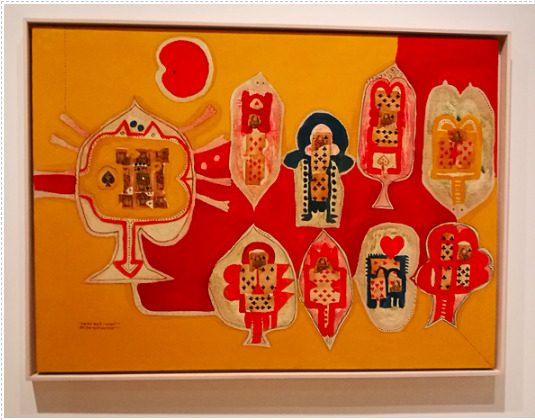
Among the some 100 works of art displayed in the gallery, are pieces by both famous and unknown Middle Eastern and Asian artists. One of the more famous artists on display is Prabhakar Barwe from India. During the tour, this was the first artist that we discussed. Barwe was active in Mumbai, India from the 1959 until his death in 1995 during his life, he was a pioneer of Modern Indian paintings. In King and Queen of Spades Barwe employs solid, contrasting colors, in a style reminiscent of Basohli painting, a school of Pahari artists who often use deep reds as yellows, as we see in the photo above.
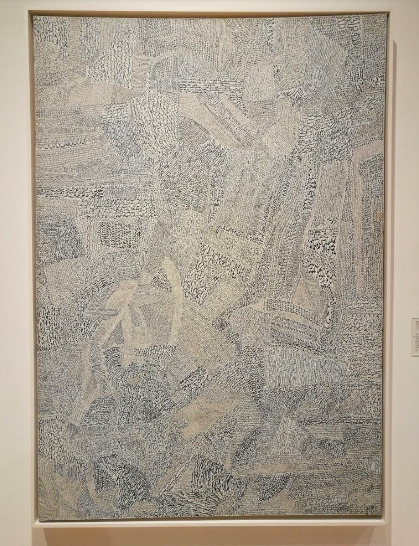
The second artist that we looked at was Siah Armajani. Armajani was born in Iran, came to the United States to study philosophy, and became an artist with a great affinity for language. He is known for his sculptures and architecture, along with his incorporation of poems and words into his works of art, such as the beautiful calligraphy seen in the piece pictured above. In this painting, inscriptions derived from stanzas of Persian poetry and numerical sequences suffuse a white pictorial field in a dense network of lines flowing in different directions.
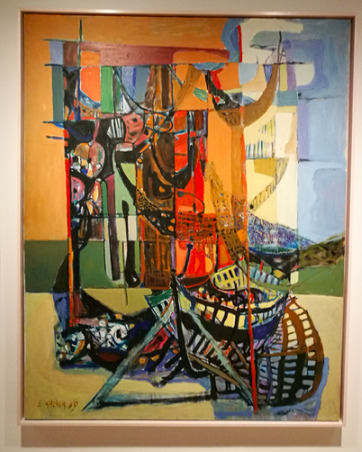
The Turkish art, located at the lower level, held works done by Ercüment Kalmık. Kalmik was an artist and art historian, known for his work in studying the lyrical-abstract Turkish painters. Kalmik graduated from The Academy of Fine Arts in Istanbul in 1937. He studied in Paris at the Sorbonne, but his studies were interrupted by the German occupation and he returned to Turkey. Back in Turkey, Kalmik worked as a newspaper illustrator and book designer. Kalmik is known as a transitional artist, one whose maturation in the 1950s coincided with a particularly intense moment of debate in Turkey, between partisans of abstraction and figuration, which is reflected within his paintings.
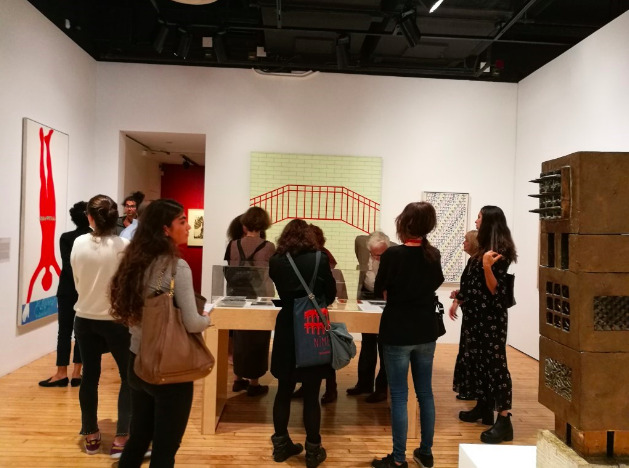
Abby Grey had a vision of uniting historical and modern works of art in a way that was both engaging and thought-provoking. Through this exhibition, each work of art contributes to this mission by focusing on the exploration and expression of its historical, cultural, and social contexts. Abby Grey’s idea was to be able to unite such different worlds as the Middle East and Asia with the American world through the process, collection, and exhibition of art. While these works of art are considered contemporary, the artists of each work still manages to portray the tradition of his/her original countries. Through our tour, we were able to get an insight of Ms. Grey’s worldly travels and what she collected along the way: pieces that were appealing to her–whether it be in the context, style, symbolism or meaning– and grouped together as an exhibit, we see how they all were works with which she connected.
